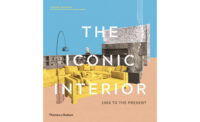George Nelson Retrospective at Yale Examines the Designer's Legacy












At first glance, there’s nothing too surprising about George Nelson: Architect, Writer, Designer, Teacher, the exhibition on view until February 2, 2013 at the Yale School of Architecture Gallery in New Haven, Conn. We recognize the architect’s iconic modern designs from the 1940s and 1950s – the Ball Clock, the Coconut Chair, the Marshmallow Sofa and the Bubble lamps – but upon closer scrutiny there’s a lot more to this first comprehensive retrospective devoted to Nelson (1908-1986). Yale is the last stop of an international, four-year tour organized by the Vitra Design Museum in Weil am Rhein, Germany.
Through more than 50 drawings, large-scale models, photos, films, graphics and 120 pieces of furniture and design objects, we discover that Nelson was a complicated man: a dedicated modernist often more interested in ideas than producing designs, a visionary about modern living, a proto-feminist, and a witty, ego-free boss who liked collaborating with – and giving full credit to – fellow talents such as Jane Thompson, Buckminster Fuller, Alexander Girard and Charles and Ray Eames.
Nelson was a skilled draftsman and passionate photographer. After earning two bachelor’s degrees (B.A., 1928; B.F. Arch., 1931) and winning a Prix de Rome, he spent two years (1932-1934) at the American Academy in Rome. The young student traveled across Europe to interview the leading architects of the time, including Mies van der Rohe, Le Corbusier, Walter Gropius and Gio Ponti, for the architecture journal Pencil Points (later renamed Progressive Architecture). His prose was clear and confident. “The Tugendhat House is Mies’s masterpiece, justly world famous, perhaps the finest modern house that has been built,” he wrote (as recorded in the fine show catalog). “Mies’s fondness for space, for simplicity, for rich materials all find expression here." Of Le Corbusier: “He is absolutely incapable of compromise solutions,” Nelson observed. “He possesses a devastating sincerity, so complete that to me it is a miracle that he has ever been able to get anything built.”
When Nelson returned to New York in 1935, he joined Architectural Forum as an associate editor and then a consulting editor. He also contributed to Life, a sister magazine in the Time Inc. stable.
Nelson came to design through writing. It was his reporting, and his pioneering book Tomorrow’s House (written with Henry Wright in 1945), that drew the attention of D. J. De Pree, the head of the Herman Miller furniture company in Michigan. After the sudden death of Gilbert Rohde, his design director, De Pree offered the job to Nelson, who took it, admitting, “I had not the slightest idea what I was getting into.”
It was a genius hire. Nelson thought America was ready for a more modern lifestyle, at home and at work, and had novel ideas about the way offices should be organized. He pushed for the open plan and storage walls, L-shaped desks, cubicles, workstations and modules that could be mixed and matched in what he called the “Action Office.” Until 1972, as design director, he oversaw graphics, corporate identity and product; he hired his talented friends Isamu Noguchi, Alexander Girard and the Eameses. Sales soared.
Nelson executed graphics and design projects for many Fortune 500 companies and organized several international exhibitions (including a few pavilions at the World’s Fair in New York in 1964). He was head designer for the American National Exhibition in Moscow in 1959, an extravaganza housed in a Bucky Fuller dome and displaying a model American house with a modern kitchen that became the backdrop of the famous Cold War Krushchev-Nixon “Kitchen Debates.”
Beginning in 1951, Nelson actively participated in the International Aspen Design Conference. He also designed some memorable restaurant and retail spaces in New York, including La Potagerie, the Rosenthal Studio-Haus on Fifth Avenue, and Barneys.
“He was a curator of life,” Yale Architecture School Dean Robert A.M. Stern said November 8 at the opening of an excellent two-day symposium on Nelson. “He took command of the full range of possibilities of what architecture could be.”
The exhibition is dense with information. “We wanted to show that Nelson is much more than just the designer of the handful of design classics everyone knows,” said Vitra Museum curator Jochen Eisenbrand. “His interest was in broader question about how we live.” Amen.








